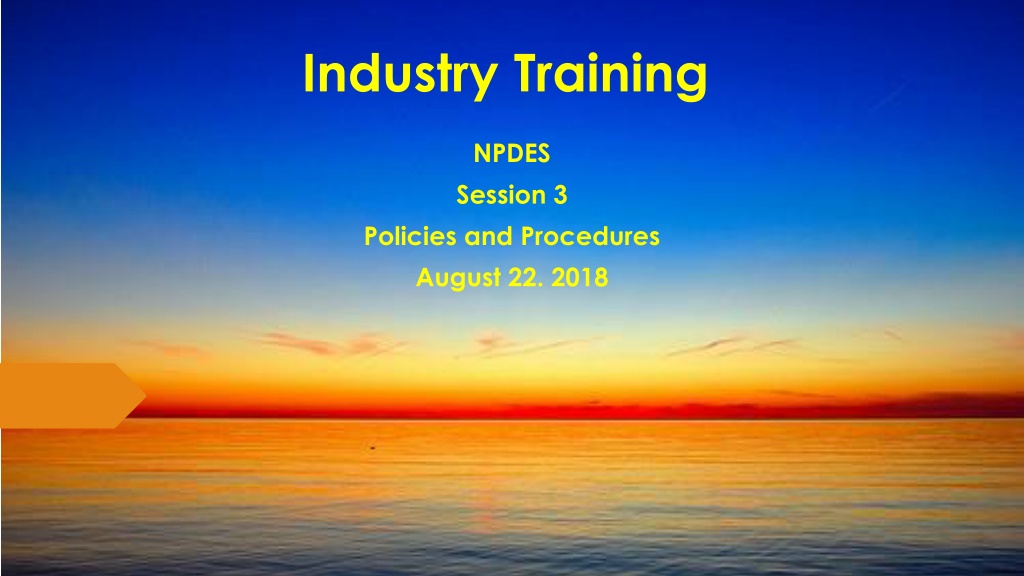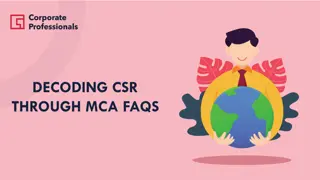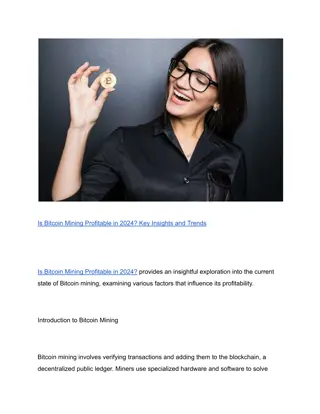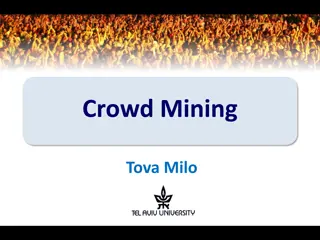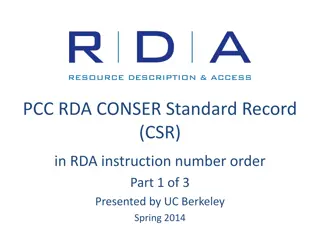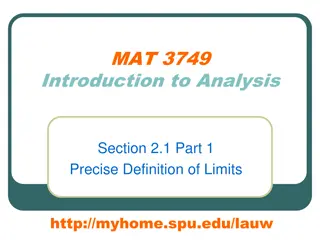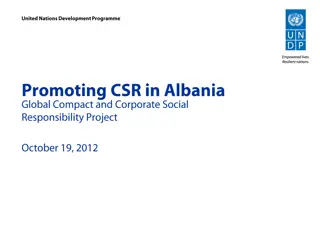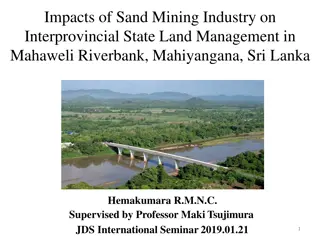Understanding Post-Mining Limits Under 47 CSR 30
Post-mining areas are classified based on completion of mining activities, contour restoration, and revegetation work. Classification is done outlet-by-outlet, with specific data requirements for precipitation-induced outlets before applying for post-mining limits. The determination for classification as a Post-Mining Area involves three factors: completion of mining, surface contour restoration, and commencement of revegetation work.
Download Presentation

Please find below an Image/Link to download the presentation.
The content on the website is provided AS IS for your information and personal use only. It may not be sold, licensed, or shared on other websites without obtaining consent from the author. Download presentation by click this link. If you encounter any issues during the download, it is possible that the publisher has removed the file from their server.
E N D
Presentation Transcript
Industry Training NPDES Session 3 Policies and Procedures August 22. 2018
Post Mining Limits Under 47 CSR 30 Dated January 3, 2014 Revised October 5, 2017
Post Mining Limits Under 47 CSR 30 Dated January 3, 2014 Under 40 CFR 434.11(k), the following operations are classified as a Post Mining Areas: (1) A reclamation area, which is the surface area of a coal mine which has been returned to required contour and on which revegetation (specifically, seeding or planting) work has commenced, or (2) The underground workings of an underground coal mine after the extraction, removal, or recovery of coal from its natural deposit has ceased and prior to bond release.
Post Mining Limits Under 47 CSR 30 Dated January 3, 2014 The determination for classification as a Post Mining Area is based on three factors: (1) Mining in the area is completed; (2) The surface area has been returned to contour; and (3) Revegetation has commenced. Summary The coal is removed, area is backfilled, graded and seeded.
Post Mining Limits Under 47 CSR 30 Dated January 3, 2014 This determination is made on an outlet-by-outlet basis. The drainage area associated with each outlet will be assessed individually to determine whether each of the three factors is satisfied. It is possible for one or more outlets to be classified as a Post-Mining Area, while other outlets do not qualify for reclassification.
Post Mining Limits Under 47 CSR 30 Revised October 5, 2017 Precipitation-Induced Outlets. Prior to applying for post-mining limits, the permittee must provide one of the following data sets for each outlet: Twelve (12) months DMR data plus 1 raw sample, if the outlet is not chemically treated; Six (6) months of raw sample data collected prior to any chemical treatment; If the outlet does not flow consistently, only flows in response to precipitation event, 12 months DMR data plus 1 raw sample (no pooled samples) with confirmation from the DEP inspector; OR If the outlet does not discharge, 12 months of DMR demonstrating no flow with confirmation from the DEP inspector.
Post Mining Limits Under 47 CSR 30 Dated January 3, 2014 The data will be compared to the corresponding outlet s effluent limitations. If the data meets all WQBELs in the permit, then the outlet will be assigned the appropriate TBELs for a Post-Mining Area specified in 40 CFR 434. WQBELs will remain in the permit for any parameter that does not meet the effluent limitations set forth in the NPDES permit.
Post Mining Limits Under 47 CSR 30 Revised October 5, 2017 Non-Precipitation Induced outlets. Prior to applying for post-mining limits, the permittee must provide 12 months raw water data for each outlet, prior to any treatment (chemical or physical). This sample needs to be taken prior to the water entering the associated control structure. All observed sources of flow, i.e. valley fill toes, deep mine discharge seals, must be sampled individually at the point of flow origin, even if they have a common outlet ( same as required by sediment control structure removal guidance). The agency will compare the data to the applicable water quality criteria. If the data does not exceed the corresponding water quality criteria, then the outlet will be assigned the appropriate TBELs for a Post-Mining Area specified in 40 CFR 434. WQBELs will remain in the permit for any parameter that exceeds the applicable water quality criteria in the receiving stream.
Permit Writers Input (Unfiltered) Most Frequent Issues Found in Application Review Submitting for Post Mining with incomplete water data if one sample for the month, they don t have documented that the other sample time was NF. They just submit the one and expect you to know whatever the reason. Water data that is missing the required sampling parameters and frequency. And sometimes enough samples.
Permit Writers Input (Unfiltered) Most Frequent Issues Found in Application Review We still have a lot of issues with post mining limits. The companies submit just a blanket request of post mining limits for outlets with incomplete data requiring multiple rounds (3-5) of corrections. I know the policies are pretty clear on what is required for post mining limits. I don t know if they don t read the policies or don t understand them. Anyway that is probably the most common misunderstanding of procedures and policies from applicants.
Permit Writers Input (Unfiltered) Most Frequent Issues Found in Application Review The only problem I have run into is on Post Mining Limitations. When some of the parameters in the raw water is above their water quality standard, but the DMR s shows it below the water quality standard. The company calls me and questions why all the parameters were not removed.
Permitting Policy for Instream Station Monitoring Frequency Dated February 9, 2017
Permitting Policy for Instream Stations Dated February 9, 2017 This memorandum establishes the requirements and procedures for reducing the monitoring frequency for instream monitoring stations. Instream monitoring is required in a permit to ensure the discharge from the mining activity does not cause or contribute to a violation of the water quality standards.
Permitting Policy for Instream Stations Dated February 9, 2017 Normally, the monitoring frequency assigned to instream stations is the same as the associated NPDES outlets. In most cases for active operations the frequency is semi-monthly. Frequency was commonly reduced to quarterly when outlets go to post mining.
Permitting Policy for Instream Stations Dated February 9, 2017
Permitting Policy for Instream Stations Dated February 9, 2017 This policy allows the frequency for instream monitoring to be reduced to monthly automatically upon permit reissuance if the permit is in (reasonable) compliance with its effluent limitations. Permits may request the instream station s frequency to be reduced by way of a minor modification. No advertisement is required. Reduced monitoring frequency shall be assessed and granted on a stream by stream basis.
Permitting Policy for Instream Stations Dated February 9, 2017 Quarterly instream monitoring may be requested if all the following circumstances are met: The mining activities have been ongoing for at least two years or mineral removal is complete and final land reclamation has been initiated. No violations of effluent limitations have occurred for the associated outlets for at least two years. The permittee has received no violations for conditions not allowable in the receiving stream for at least two years.
Permitting Policy for Instream Stations Dated February 9, 2017 Quarterly instream monitoring may be requested if all the following circumstances are met:
Permitting Policy for Instream Stations Dated February 9, 2017 Quarterly Monitoring
Permitting Policy for Instream Stations Dated February 9, 2017 Quarterly Monitoring
Permitting Policy for Instream Stations Dated February 9, 2017 Quarterly Monitoring
Permitting Policy for Instream Stations Dated February 9, 2017 Semi-Annual Monitoring
Permitting Policy for Instream Stations Dated February 9, 2017 Permit Condition Showing Instream Station Monitoring Frequency D.8 Instream Station Monitoring frequency: Instream Station monitoring frequencies are as follows: All other requirements of Section D 3 apply as specified. USTB- Semi-Monthly DSTB-Semi-Monthly USRB-Monthly DSRB-Monthly USDCC-Quarterly DSDCC-Quarterly Or if all are the same frequency: All stations -Monthly (or whatever frequency is applicable)
Permitting Policy for Precipitation Induced Outlets Dated November 28, 2016
Permitting Policy for Precipitation Induced Outlets Dated November 28, 2016 This policy establishes the procedures and practices for permitting precipitation induced outlets to coincide with our permitting of such outlets with respect to our Narrative Water Quality Standards. The Narrative Guidance does not apply to outlets that are precipitation induced. Water quality effluent limits need not be applied to precipitation induced discharges.
Permitting Policy for Precipitation Induced Outlets Dated November 28, 2016 Precipitation induced outlets will have technology based effluent limits along with benchmark monitoring criteria for instream monitoring stations. This policy defers a BWQ Tier 2 Antidegradation review in lieu of establishing benchmarks in the receiving stream. BWQ collection shall be done using the 7Q10 rain gauge protocol only. Any Tier 2 review will not include acreage contributed from precipitation outlets. Only non-precip outlets will be assessed.
Permitting Policy for Precipitation Induced Outlets Dated November 28, 2016 New permits, permit modifications and reissuances will be permitted in accordance with this policy. NPDES permits will be revised to be consistent with this policy upon reissuance. A permittee may apply for a Major Modification to apply this policy prior to reissuance of the permit. The permit modification will be considered on an outlet by outlet basis and may be granted only if the permittee can demonstrate that each requested outlet discharges solely in response to precipitation events
Permitting Policy for Precipitation Induced Outlets Dated November 28, 2016 The review will be conducted on a parameter by parameter basis. No change will be available for any parameter which effluent limitations were established in accordance with an approved TMDL or where the immediate receiving stream is listed as impaired in the operative 303d list.
Permitting Policy for Precipitation Induced Outlets Dated November 28, 2016 For other parameters not included in the ELG s (40 CFR 434) but may require limitations to be applied; the most stringent acute value will be assigned. When additional parameters are added to the outlet(s), an instream benchmark value must be added to the permit condition utilizing the most stringent chronic criteria. Aluminum Where applicable, surrogate tech-based limitations of 3.0 mg/l AML and 6.0 mg/l MDL shall be applied for Total Aluminum. Selenium Where applicable, outlets will be assigned report only monitoring for the AML and MDL.
Permitting Policy for Precipitation Induced Outlets Dated November 28, 2016 The new Precipitation Induced Outlet Condition replaces the Special Sampling Condition. The language and specifics are the same, except the new Precipitation Induced Outlet Condition contains a set of Benchmark values to be applied to the instream monitoring stations. The benchmark values will be specific to the parameters of concern and the type of stream (warm or cold water).
Precipitation Induced Outlet Condition In the event of a rainfall event equal to or greater than 0.3 inches occurs, during each calendar month monitoring will be conducted for the constructed on-bench outlet (precipitation induced) which has been disturbed by mining activity with the largest component drainage area and the constructed on-bench outlet (precipitation induced) at the lowest elevation on the down dip portion of the operation that has been disturbed by mining activity. The stream monitoring stations associated with these outlets must also be monitored at approximately the same time. The monitoring can be initiated at any point after rain gauge data indicates 0.3 inches of precipitation has occurred and shall be completed within eighteen (18) hours after cessation of the precipitation event. A qualifying event defined herein as any event where 0.3 inches or more of rainfall occurs within a consecutive 24 hour period. In the event of a discharge from the precipitation induced outlets is sampled, the sample(s) must be analyzed for all parameters listed in Section A of the permit for each respective outlet and parameters listed in Section D,3 of the permit for the associated stream monitoring station(s). Analysis must be reported as a regular discharge monitoring report (DMR) and may be substituted for one of the required semi-monthly samples for the outlet(s). Once a qualified event is sampled in a given calendar month, this condition is satisfied for that calendar month. Rain gauge information must be maintained during the term of the life of the permit and made available to the Director upon request.
Permitting Policy for Precipitation Induced Outlets Dated November 28, 2016 New Reporting Forms must be completed, signed and submitted with the ESS Quarterly Discharge Monitoring Report (DMR) submittal. The original signed form(s) must be submitted to the permit inspector in the appropriate regional office.
Permit Writers Input (Unfiltered) Most Frequent Issues Found in Application Review I am noticing the NWQS justification is not being compiled correctly. Companies are not justifying Non Precip vs Precip. They want to call everything substantially complete. NWQ needs more detailing.
Permit Writers Input (Unfiltered) Most Frequent Issues Found in Application Review Provide better description in Module 11 Narrative and make sure it matches what is being requested in the Art. 3 application if associated. Make sure they are using the correct BWQ protocol now for non-precip outlets. Provide Table C analysis. They have 2 years prior to collect this data but are submitting without. Also delays when an issue pops up with that analysis causing delays in permitting times.
Permit Writers Input (Unfiltered) Most Frequent Issues Found in Application Review Provide better description in Module 11 Narrative and make sure it matches what is being requested in the Art. 3 application if associated. The companies and consultants understand the new policies to the point of asking for them in a permitting action. However, they are failing to add the supporting documents necessary to be granted the policies that grant any type of relief. This requires one and sometimes two rounds of corrections for the supporting documentation.
Permit Writers Input (Unfiltered) Most Frequent Issues Found in Application Review Companies not resubmitting the corrections within 30 days is becoming a real problem. We also need to remind the companies that when a permitting action is submitted they also need to submit the required filing fees associated. Make a quick word to them about submitting incomplete applications, no water data, which they are just trying to get an application in and get out of hot water with I & E.
